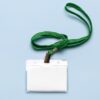The name badge is not just a means of carrying your identity. Still, it serves as an essential method of greeting and interaction in formal and informal scenarios, from conferences to company events or retail environments. In the article below, we will discuss a few basic rules of wearing name badges, etiquette for name badges, the differences between name tags and name badges, and what rule observance is for.
What is the Proper Location for a Name Badge?
A name badge should be placed on the right upper side of your chest. This position is not accidental and carries some practical meaning. It is natural for a person’s line of sight to be toward your right side when extending a hand to shake yours. You are making it easier to view the name without looking away or adjusting their gaze by placing your badge on the right side. Minor points of attention like these often result in smoother, more personal introductions that make for an excellent first impression.
Furthermore, the positioning of the name badge on the right side aligns with the direction of the conversation. Most individuals use their right hand, so this ensures that your right hand will appear during the initial handshake and immediately identifies you to the other person. It can make this contact easier to follow through with the interaction of the individual in a much smoother manner, particularly in professional circles where first impressions can mean quite a bit.
What Side Should a Woman Wear a Name Badge?
The rules of etiquette regarding name badges are the same for both men and women. A woman also has to wear her identification badge on the right upper side of the chest. This serves to universalize the practice so that all persons can quickly identify each other without any problem. Keeping the name badge on the right side is the accepted rule in a board meeting, a networking function, or a socializing event.
There are, however, a few things women should consider. For example, if a woman is wearing a blouse or dress with detailed designs or adornments on the right side, it may be very tempting to place the name badge on the left side to avoid interference. While it may seem like a good idea, it’s better to stick with the rule again. You can adjust it to avoid covering all the details of the clothes while ensuring it remains as right-sided as possible.
Why Is It Important to Wear a Name Badge?
Wearing a name badge has more to it than being a formality; it helps develop communication and enhances relationships. Here’s why this should be done while keeping in mind the etiquette for name badges:
- Instant Recognition: The name badges ensure instant recognition, and people instantly come to know who you are. This is quite helpful in significant events where it is difficult to remember the names of all the participants.
- Professionalism: A name badge adds to the professional look of the individual; it depicts that the individual is part of the event or organization and may be contacted for discussion.
- Accountability: In retail, for instance, or customer service, name badges ensure that one’s tag is always displayed for transparency and accountability.
- Networking: Networking events are places where one can wear name badges to start conversations. They eliminate the awkwardness of forgetting someone’s name and more easily initiate conversations.
The proper etiquette in name badges should, therefore, boost your professional image and assist in making interactions flow smoother and making connections better.
What is the Difference Between a Name Tag and a Name Badge?
While “nametag” and “name badge” are often used synonymously, there is a difference between them. Understanding the differences can enable you to choose appropriately for any given situation.
Name Tag
The name tag is usually temporary. Generally, paper or plastic is usually used for conferences, meetings, and other events that only last for a short period. Many name tags are adhesive and may stick to the clothes. They are relatively easy to make and hand out but may not indicate permanency or professionalism.
Name Badge
On the contrary, the name badge is much stronger and more permanent. You can make this out of metal or appropriate plastic and it typically includes a name, title, and possibly the company logo. Generally, they use a magnet or pin to fasten and design them for multiple uses. These are more usual in professional conditions that call for more polish.
In short, people usually apply name tags in casual or temporary settings and use name badges for formal and long-term ones. Once you know the difference, it will be easy to choose which one you use depending on the occasion.
Do You Put Your Last Name on a Name Tag?
Whether to include your last name or not on a name tag depends on the occasion and the event’s formality. Having your first and last names on name tags in a professional setting is always good. This will give complete identification, which may mean nothing if you are attending some small party, but is relevant if you happen to be at a big meeting where somebody else might be with your very same first name.
Casual or informal events may only require the first name, especially if the event is small or if the atmosphere needs to be relaxed. For instance, a first name would create an approachable and friendly atmosphere if it were a team-building exercise or a casual social get-together.
When designing a name tag, consider the event it is for and its level of formality. In certain instances, adding a last name can enhance professionalism and facilitate proper identification.
Do People Wear Name Tags at Funerals?
Wearing name tags at funerals is unusual and generally not considered decent. This is because this is one solemn occasion where people gather to give respect and memory to the dead, and the occasion’s solemnity is not in scope with name tags.
Depending on the culture and size of the gathering or particular requests from the family, people could accept this. Organizers can provide discreet name tags at large funerals where attendees may not know each other. This scenario is rare and they should offer it with the utmost respect and tact.
Unless informed otherwise that it is appropriate, you cannot put on a name tag when attending a funeral. A safe practice is to stay away from wearing it.
Conclusion
To deliver the appropriate message, conversing about how to wear name badges is essential, whether in professional or social circles. Wearing one’s name badge on the upper right side of the chest, with both first and last names where appropriate, and learning the difference between a name tag and a name badge will deliver confidence in these varied situations. A name badge is small, but in communication and professionalism, it says much to ensure you are approachable, identifiable, and respectful in all of your interactions.
When it comes to choosing the right material for your name badges, metal badges stand out for their durability and professional appearance. These badges are not only sturdy but also exude a polished look, making them ideal for long-term use in corporate environments, conferences, and formal events. You can order now if you’re looking to invest in high-quality metal badges. Now is the perfect time to request a quote and explore the customization options that can enhance your brand’s visibility and professionalism.







